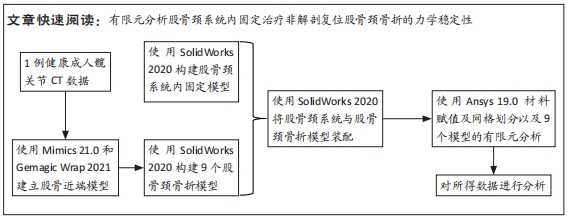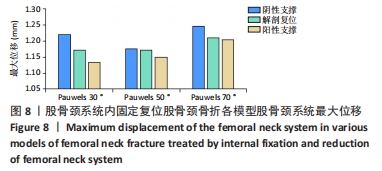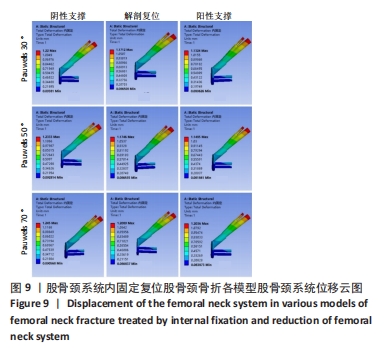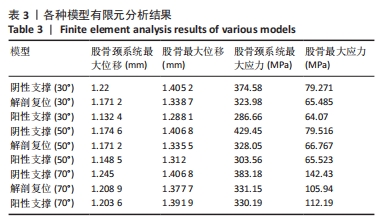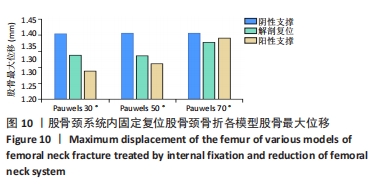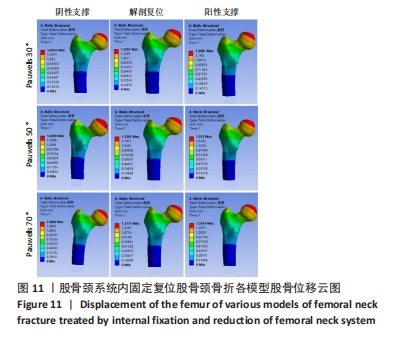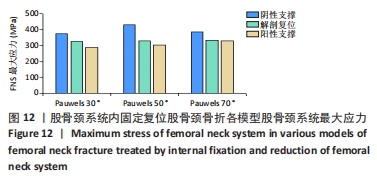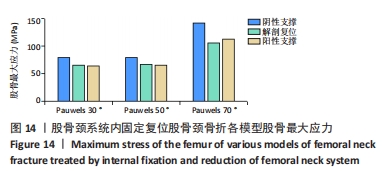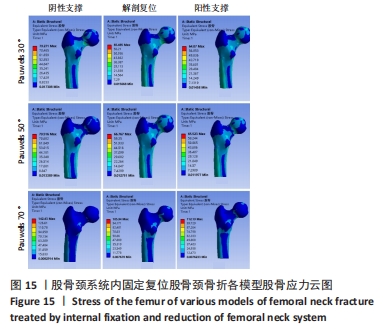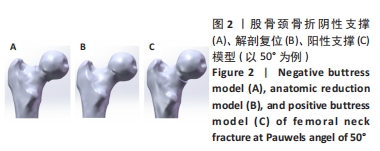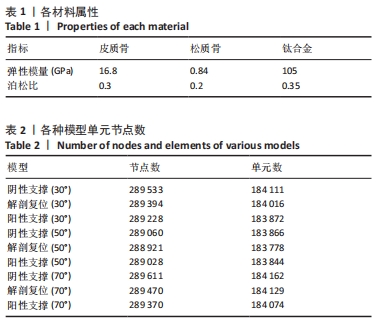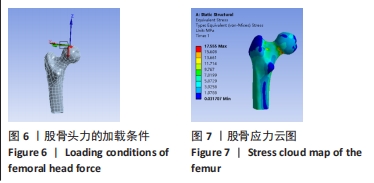[1] ZELLE BA, SALAZAR LM, HOWARD SL, et al. Surgical treatment options for femoral neck fractures in the elderly. Int Orthop. 2022;46(5):1111-1122.
[2] GUYEN O. Hemiarthroplasty or total hip arthroplasty in recent femoral neck fractures? Orthop Traumatol Surg Res. 2019;105(1S): S95-S101.
[3] WANG Y, MA J X, YIN T, et al. Correlation Between Reduction Quality of Femoral Neck Fracture and Femoral Head Necrosis Based on Biomechanics. Orthop Surg. 2019;11(2):318-324.
[4] ZHAO F, GUO L, WANG X, et al. Analysis on risk factors for neck shortening after internal fixation for Pauwels II femoral neck fracture in young patients. Eur J Med Res. 2021;26(1):59.
[5] QIU L, HUANG Y, LI G, et al. Essential role of reliable reduction quality in internal fixation of femoral neck fractures in the non-elderly patients-a propensity score matching analysis. BMC Musculoskelet Disord. 2022; 23(1):346.
[6] ZHUANG L, WANG L, XU D, et al. Anteromedial femoral neck plate with cannulated screws for the treatment of irreducible displaced femoral neck fracture in young patients: a preliminary study. Eur J Trauma Emerg Surg. 2019;45(6):995-1002.
[7] PATTERSON JT, ISHII K, TORNETTA P 3RD, et al. Open Reduction Is Associated With Greater Hazard of Early Reoperation After Internal Fixation of Displaced Femoral Neck Fractures in Adults 18-65 Years. J Orthop Trauma. 2020;34(6):294-301.
[8] JU FX, HOU RX, XIONG J, et al. Outcomes of Femoral Neck Fractures Treated with Cannulated Internal Fixation in Elderly Patients: A Long-Term Follow-Up Study. Orthop Surg. 2020;12(3):809-818.
[9] PEI F, ZHAO R, LI F, et al. Osteonecrosis of femoral head in young patients with femoral neck fracture: a retrospective study of 250 patients followed for average of 7.5 years. J Orthop Surg Res. 2020; 15(1):238.
[10] GOTFRIED Y. The Gotfried (Nonanatomic, Closed) Reduction of Unstable Subcapital Femoral Fractures. J Tech Orthop. 2012;27(4): 259-261.
[11] WANG G, WANG B, TANG Y, et al. A quantitative biomechanical study of positive buttress techniques for femoral neck fractures: a finite element analysis. Chin Med J (Engl). 2019;132(21):2588-2593.
[12] ZHU J, LI Y, ZHANG Y, et al. Clinical Outcome and Biomechanical Analysis of Dynamic Hip Screw Combined with Derotation Screw in Treating Displaced Femoral Neck Fractures Based on Different Reduction Qualities in Young Patients (≤65 Years of Age). Biomed Res Int. 2022;2022:9505667.
[13] STOFFEL K, ZDERIC I, GRAS F, et al. Biomechanical Evaluation of the Femoral Neck System in Unstable Pauwels III Femoral Neck Fractures: A Comparison with the Dynamic Hip Screw and Cannulated Screws. J Orthop Trauma. 2017;31(3):131-137.
[14] FAN Z, HUANG Y, SU H, et al. How to choose the suitable FNS specification in young patients with femoral neck fracture: A finite element analysis. Injury. 2021;52(8):2116-2125.
[15] DEPUY S. Femoral neck system surgical technique. 2017[2022-12-05]. https://www.jnjmedtech.com/en-US/pdf/syntheslimelight-103452913-rev-epdf.
[16] 范智荣,苏海涛,周霖,等.新型股骨颈内固定系统治疗不稳定性股骨颈骨折的有限元分析[J].中国组织工程研究,2021,25(15):2321-2328.
[17] NAN C, MA L, LIANG Y, et al. Mechanical effects of sagittal variations on Pauwels type III femoral neck fractures treated with Femoral Neck System(FNS). BMC Musculoskelet Disord. 2022;23(1):1045.
[18] JIANG X, LIANG K, DU G, et al. Biomechanical evaluation of different internal fixation methods based on finite element analysis for Pauwels type III femoral neck fracture. Injury. 2022;53(10):3115-3123.
[19] ZHAN S, JIANG D, XU J, et al. Influence of the proximal screws of buttress plates on the stability of vertical femoral neck fractures: a finite element analysis. BMC Musculoskelet Disord. 2020;21(1):842.
[20] LI J, YIN P, ZHANG L, et al. Medial anatomical buttress plate in treating displaced femoral neck fracture a finite element analysis. Injury. 2019; 50(11):1895-1900.
[21] ZHOU L, LIN J, HUANG A, et al. Modified cannulated screw fixation in the treatment of Pauwels type III femoral neck fractures: A biomechanical study. Clin Biomech (Bristol, Avon). 2020;74:103-110.
[22] VAN HOUCKE J, SCHOUTEN A, STEENACKERS G, et al. Computer-based estimation of the hip joint reaction force and hip flexion angle in three different sitting configurations. Appl Ergon. 2017;63:99-105.
[23] LI J, WANG M, ZHOU J, et al. Finite element analysis of different screw constructs in the treatment of unstable femoral neck fractures. Injury. 2020;51(4):995-1003.
[24] 陈继铭, 欧阳汉斌, 吴晓静, 等. 基于复合人工股骨的有限元模型构建及有效性验证验证[J]. 重庆医科大学学报,2021,46(3):296-300.
[25] GOTFRIED Y, KOVALENKO S, FUCHS D. Nonanatomical reduction of displaced subcapital femoral fractures (Gotfried reduction). J Orthop Trauma. 2013;27(11):e254-e259.
[26] ZHAO G, LIU M, LI B, et al. Clinical observation and finite element analysis of cannulated screw internal fixation in the treatment of femoral neck fracture based on different reduction quality. J Orthop Surg Res. 2021;16(1):450.
[27] 郑翔, 许锦煌, 黄建荣. 两种非解剖复位内固定Pauwels Ⅲ型头下型股骨颈骨折的有限元分析[J]. 中国临床解剖学杂志,2017,35(6): 665-670.
[28] COUTTS LV, JENKINS T, OREFFO ROC, et al. Local Variation in Femoral Neck Cortical Bone: In Vitro Measured Bone Mineral Density, Geometry and Mechanical Properties. J Clin Densitom. 2017;20(2): 205-215.
[29] ZHANG YQ, CHANG SM. Mechanism of “Gotfried reduction” in femoral neck fracture. J Orthop Trauma. 2013;27(12):e291.
[30] ZHAO G, LIU C, CHEN K, et al. Nonanatomical Reduction of Femoral Neck Fractures in Young Patients (≤65 Years Old) with Internal Fixation Using Three Parallel Cannulated Screws. Biomed Res Int. 2021;2021: 3069129.
[31] 丁舒晨, 虞荣斌, 葛云林, 等. Gotfried阳性支撑复位结合空心螺钉内固定治疗中青年股骨颈骨折的近期疗效[J] 中华创伤骨科杂志,2016,18(8):655-661.
[32] HUANG K, FANG X, LI G, et al. Assessing the effect of Gotfried reduction with positive buttress pattern in the young femoral neck fracture. J Orthop Surg Res. 2020;15(1):511.
[33] WANG G, WANG B, WU X, et al. Gotfried positive reduction promotes the repair of femoral neck fracture potentially via enhancing osteogenesis and angiogenesis. Biomed Pharmacother. 2020;123: 109801.
[34] KANG JS, MOON KH, SHIN JS, et al. Clinical Results of Internal Fixation of Subcapital Femoral Neck Fractures. Clin Orthop Surg. 2016;8(2): 146-152.
[35] SLOBOGEAN GP, STOCKTON DJ, ZENG B, et al. Femoral Neck Fractures in Adults Treated With Internal Fixation: A Prospective Multicenter Chinese Cohort. J Am Acad Orthop Surg. 2017;25(4):297-303.
[36] XIONG WF, CHANG SM, ZHANG YQ, et al. Inferior calcar buttress reduction pattern for displaced femoral neck fractures in young adults: a preliminary report and an effective alternative. J Orthop Surg Res. 2019;14(1):70.
[37] AUGAT P, BLIVEN E, HACKL S. Biomechanics of Femoral Neck Fractures and Implications for Fixation. J Orthop Trauma. 2019; 33 Suppl 1: s27-s32.
[38] TIANYE L, PENG Y, JINGLI X, et al. Finite element analysis of different internal fixation methods for the treatment of Pauwels type III femoral neck fracture. Biomed Pharmacother. 2019;112:108658.
[39] MA J, ZHAO Z, ZHI X, et al. Finite element comparative analysis of three different internal fixation methods in the treatment of Pauwels type III femoral neck fractures. BMC Musculoskelet Disord. 2022;23(1):1030.
|
